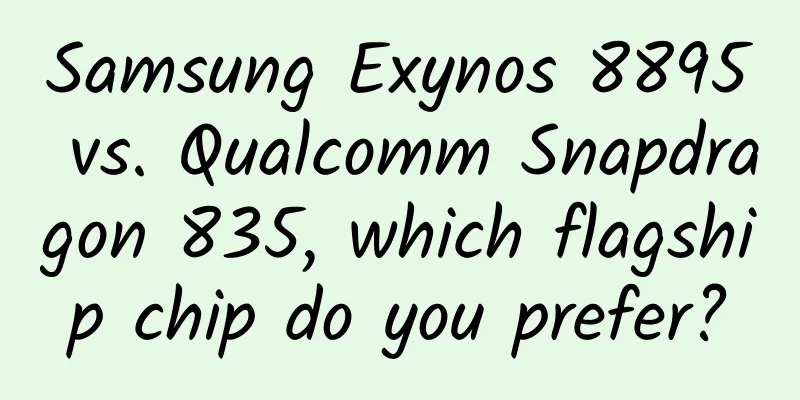Samsung Exynos 8895 vs. Qualcomm Snapdragon 835, which flagship chip do you prefer?

|
With the official announcement of Samsung's new generation 9 series processor Exynos 8895 a few days ago, the first wave of the most powerful mobile processors in 2017 has been fully disclosed, namely Qualcomm's Snapdragon 835 and Samsung's Exynos 8895. Interestingly, Samsung's new generation flagship smartphones will use both processors and will be officially shipped in April if nothing unexpected happens. Many mobile phone users are now discussing whether Qualcomm or Samsung is better. Considering that there are no finished devices with Snapdragon 835 and Exynos 8895, it is impossible to actually compare them. However, we can learn which one has the advantage in terms of performance and features from the official information released by Qualcomm and Samsung. Let's take a look at the comparison chart of the last two generations of Qualcomm and Samsung mobile flagship chips: Performance Expectations Comparison In 2017, we went from quad-core to octa-core processors again, but the biggest difference is that both Qualcomm and Samsung have started to customize CPU cores. The war between chips is still so familiar, and although there are no real finished products yet, both companies have begun to brag about how amazing performance and energy efficiency improvements various new chips can provide. Qualcomm boasted that the Snapdragon 835 had a 20% performance improvement over the 821, while Samsung touted that the Exynos 8895 had a 27% performance improvement over the Exynos 8890. However, Samsung's PR seemed to reveal its conservative side, because since it is the 9 series, why didn't they name it with a "9" at the beginning, but chose to add a "5" at the end? In terms of chip customization, Qualcomm's Kryo 280 core is still a semi-custom core based on ARM, while Samsung designed a large core based on the familiar big.LITTLE configuration through the ARMv8 ISA license. We don’t know the exact design and improvements Qualcomm and Samsung made inside the chip, but the focus is definitely on optimizing performance and energy efficiency. Thanks to Samsung’s latest 10nm FinFET process, the power consumption of both chips is 40% lower than the previous generation. In this way, since the flagship chips of the past two years are all manufactured by Samsung, and the performance of the previous generation is so close, the actual comparison results in 2017 should not be too far off. Putting aside the CPU, the GPU is the most worthy part of the two companies' competition. We also see that the two companies have made a lot of claims about the performance of the graphics processor. Qualcomm upgraded the Adreno 530 to the Adreno 540, and the 3D rendering performance increased by 25%. Samsung uses ARM's latest Mali-G71 MP20, which is a 20-core GPU configuration. Compared with the previous generation Mali-T880 MP12, not only the energy efficiency has been improved by 20%, but also the core density has been increased by 40%, and it occupies less space, so Samsung was able to cram in 8 additional cores. Samsung officials said that this is a leap-forward performance improvement, which is about "60" higher than the previous generation. Last year, in the GPU performance showdown between Qualcomm Snapdragon 821 and Samsung Exynos 8890, Samsung was outperformed. It seems that Samsung plans to narrow the gap with Qualcomm in GPU performance, and may even surpass it. Camera and Vision Processing Dual cameras are growing rapidly this year, and it is said that Samsung's flagship has also joined the dual camera configuration. In any case, both Samsung Exynos 8895 and Qualcomm Snapdragon 821 support dual camera technology, the difference is that the former supports a combination of 28 million pixels + 16 million pixels, while the latter supports up to dual 16 million pixels. Of course, actual devices cannot be equipped with sensors with such high pixels, and high pixels do not necessarily mean superior image quality. Dual cameras are currently inferior to single-lens phones with larger sensors and single pixel sizes in terms of image quality, but they bring many professional camera features, such as "optical zoom", telephoto, wide viewing angle, HDR enhancement, focus after shooting, and depth of field blur. In addition to the basic functions, Samsung has added a VPU visual processing unit to the Exynos 8895, which is mainly responsible for analyzing the visual information captured by the camera, and can identify and analyze the movement trajectory of objects, greatly enhancing the performance of motion detection, video tracking and panoramic shooting. Qualcomm also boasted about its own improvements to the VPU, claiming to have added support for 10-bit color, which can also capture target detection, facial recognition and gesture detection, and even be used for VR and AR applications. In addition, Snapdragon 835 currently supports 4K @ 30fps video recording, but Samsung is slightly better, supporting 4K @ 120fps video capture. Qualcomm said that Snapdragon 835 can better support deep machine learning thanks to the improved Hexagon DSP and Symphony, and Samsung's biggest breakthrough is also here. The upgraded SCI supports the HAS heterogeneous system architecture for the first time, ensuring the consistency of the high-speed cache between the CPU and GPU, which is more conducive to the fast computing needs of AI artificial intelligence and deep learning. Faster data transfer speeds One of the biggest highlights of Qualcomm Snapdragon 835 is the built-in X16 Gigabit LTE modem, which can achieve a peak downlink speed of 1Gbps and an uplink speed of 150Mbps, and it was tested in Australia some time ago. Samsung does not seem to be jealous at all, because Samsung also has its own powerful modem and has caught up with 835 in terms of speed this year, with peak uplink and downlink speeds equal to Qualcomm, and provides 5-band carrier aggregation higher than 835. With the popularization of Gigabit LTE, online 4K video playback and real-time VR live broadcast will become easier. Of course, peak speed does not represent the actual speed, but the performance will be better in some areas where high-speed LTE networks are truly available, after all, multi-band carrier aggregation technology has been improved. In addition, mobile phones equipped with 835 and Exynos 8895 will not be outdated at all in the development of 4G networks, at least in the next few years. summary Although Qualcomm and Samsung have designed different latest generation SoCs in different ways, there are many overlapping functions between the two. Qualcomm has enhanced the functions of DSP, ISP and other components while returning to the octa-core design, while Samsung has made significant improvements in GPU, LTE and ISP. It is difficult to distinguish a few unique features between the two at present, for example, Samsung has added 4K 120fps video shooting, and Qualcomm has Quick Charge 4 fast charging. To be honest, the hidden highlights of both chips are heterogeneous computing platforms. Qualcomm builds them through a combination of CPU, GPU, DSP and software framework, and Samsung also upgrades SCI to support HAS heterogeneous system architecture for the first time. Although these are things that you can't see in daily life, it is these in-depth technical features that make the potential of the two chips even greater. In short, we hope that Snapdragon 835 and Exynos 8895 mobile phones will be launched soon to see the real competition between the two in terms of performance and functions. As a winner of Toutiao's Qingyun Plan and Baijiahao's Bai+ Plan, the 2019 Baidu Digital Author of the Year, the Baijiahao's Most Popular Author in the Technology Field, the 2019 Sogou Technology and Culture Author, and the 2021 Baijiahao Quarterly Influential Creator, he has won many awards, including the 2013 Sohu Best Industry Media Person, the 2015 China New Media Entrepreneurship Competition Beijing Third Place, the 2015 Guangmang Experience Award, the 2015 China New Media Entrepreneurship Competition Finals Third Place, and the 2018 Baidu Dynamic Annual Powerful Celebrity. |
Recommend
A brief analysis of the impact of EPA budget cuts on automakers and emissions testing
According to foreign media (http://www.hybridcars...
10 bad habits that cancer cells love the most! If you don't pay attention, they will hollow out your body~
People always want to find some time and space fo...
Master these seven principles to improve user login success rate!
TCC Recommendation: Hello everyone, this is TCC T...
Daily Fresh Product Analysis Report
On June 25, 2021, MissFresh was officially listed...
High-altitude "crisis"! How strong is the cosmic radiation that causes cancer in flight attendants?
Recently, a piece of news caught our attention. A...
Content is king, but platform and environment are God!
We live in an age where it seems like media compa...
The most comprehensive guide to placing Toutiao search ads!
ByteDance has been continuously developing its se...
Yongge's Xiaohongshu quick money-making project
Yongge's Xiaohongshu quick money-making proje...
Advertising: 5 factors affecting exposure
The first step in advertising is to gain exposure...
Security is just like the popularization of computer Internet of Things 20 years ago. How to overcome the hurdle of hackers?
Compared with ordinary homes, smart homes not only...
My ankles ache slightly when it rains. Is this a disease?
Author: Tang Qin, Researcher of Chinese Medical A...
How do novice bidders analyze keyword reports?
As a bidder, one of the must-do things every day ...
Which one is better, Youqianhua or 360 IOU?
Recently a friend asked me which one is better, Y...
Wintersweet is not a plum, broccoli is not a flower, and the X on your ID card is not a cross…
Review expert: Wei Deyong, member of Shenzhen Wri...
How much does it cost to join the Pingliang specialty mini program?
How much does it cost to join the Pingliang Speci...









